Roofing is an important aspect of home repair and maintenance. While the initial investment can be high, it will save you money in the long run by protecting your home from leaks and other damage that can cost thousands to repair or replace. When considering what type of roofing to install, however, it’s important to consider how long you expect your roof to last.
Moreover, the growing disposable income in developed countries has motivated individuals to spend on home improvement. Countries like the US, Canada, the U.K., and others have seen an upsurge in spending habits due to the constantly increasing disposable income. Leaky roofs can be the cause of headaches while disturbing the harmony and peace of the household. If you live in Montgomery County, Pennsylvania, then roofers in Montgomery County, PA, can provide exactly what you need for your next home improvement plan.
Here are five types of roofing materials with their pros and cons for different climates:
Asphalt Shingles
Asphalt shingles have gained a high acceptance rate among the types of roofing. They are less costly, easy to install, and last about 20 years. They are built from recycled materials such as plastic bottles and have a relatively low environmental impact.
Asphalt shingles come in many styles and colors, so you can get a roof that fits your home’s style or current decorating trends.
Metal Roofing
Metal roofs last longer than asphalt shingles. Metal roofing materials are designed in a way to withstand the elements, whether it’s hail or wind damage, or extreme heat, so you won’t have to see your roof falling apart prematurely.
Metal roofs also resist fire better than asphalt shingles do. While they can still catch fire, metal is much less flammable than other building materials, such as wood and drywall, making it a great choice for homes in high-risk areas with regular wildfires or brush fires nearby.
Clay or Concrete Tiles
Clay or concrete tiles are the most durable roofing material available. They are up to five times more durable than asphalt shingles and up to three times longer than metal roofs, making them a great choice for different types of climates. Natural clay and hard minerals are used to make clay tiles, while concrete tiles are made of clay-based materials coated with a layer of cement. Both types can endure extreme weather conditions and will not rot or rust over time, which brings down the need for maintenance down the road.
Roofing made from these materials is suitable for every roof type such as flat roofs that don’t need drainage systems due to having any pitch at all—a feature shared by other types like flat roofs atop factories or warehouses where water needs must be contained within specific areas during inclement weather conditions like heavy rainfalls or snowstorms. This makes them excellent choices if you live somewhere where these kinds of conditions could often happen throughout each year – so keep this in mind before deciding which type might work best for your own situation too.

Wood Shingles or Shakes
Wood shingles are an excellent choice for extreme weather conditions. By installing wood shingles, homeowners can reap multiple benefits. They can be used in different types of climates and on various roofing types, including asphalt shingle roofs. Wood shingles provide an aesthetic appeal that many homeowners enjoy.
However, wood is more vulnerable to warping during humidity changes than other kinds of materials, making it less durable over time. If you’re interested in installing wood siding on your home rather than wood shingles or shakes on your roof, consider using cedar instead of pine or hemlock because they’re less prone to damage due to climate changes.
Slate Shingles
Slate shingles are a natural material that is generally extracted from slate deposits. Slate is one of the oldest roofing materials, and it has been used for centuries. Shingle-style roofs that use slate will have a more conventional look and feel in comparison with other kinds of roofing available today.
The cost of repointing or repairing damaged slates is usually higher than with asphalt shingle repairs as well because there are fewer companies around with experience working with slates or making replacement pieces for them. You may find that you need to hire an expert who specializes in slate repair to do any work on your property if you decide not to get new ones installed right away.
In Conclusion
I hope you have got a better understanding of the different types of roofing available. Remember to choose the roofing material based on the climate and how a roof will be used. In areas that are prone to heavy snowfall, a heavier material may be required for adequate support. For a beach house that’s rarely occupied, lightweight materials may be feasible because they will minimize the weight of snow or ice resting on the roof.
Moreover, take your budget into account while planning to repair or replace the roofs. Roofs are expensive to replace and repair. As you research a wide variety of roofing, consider their cost as well as their lifespan and maintenance needs before making any decisions about which type of material to choose for your home’s exterior covering system.






